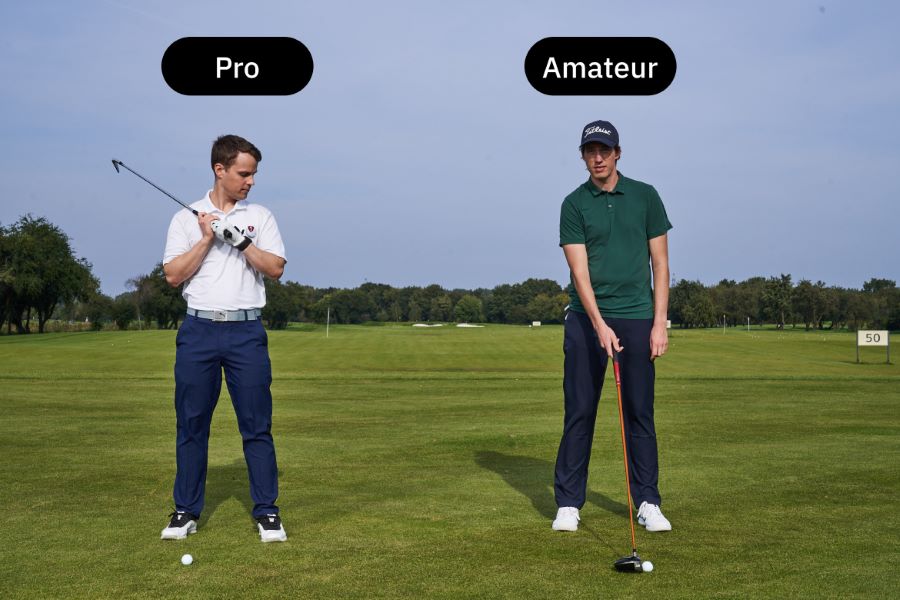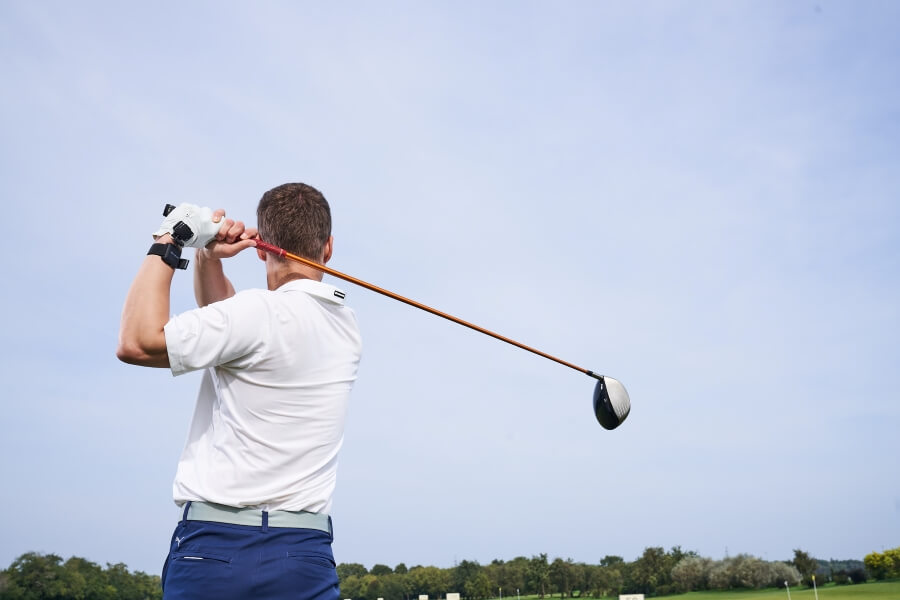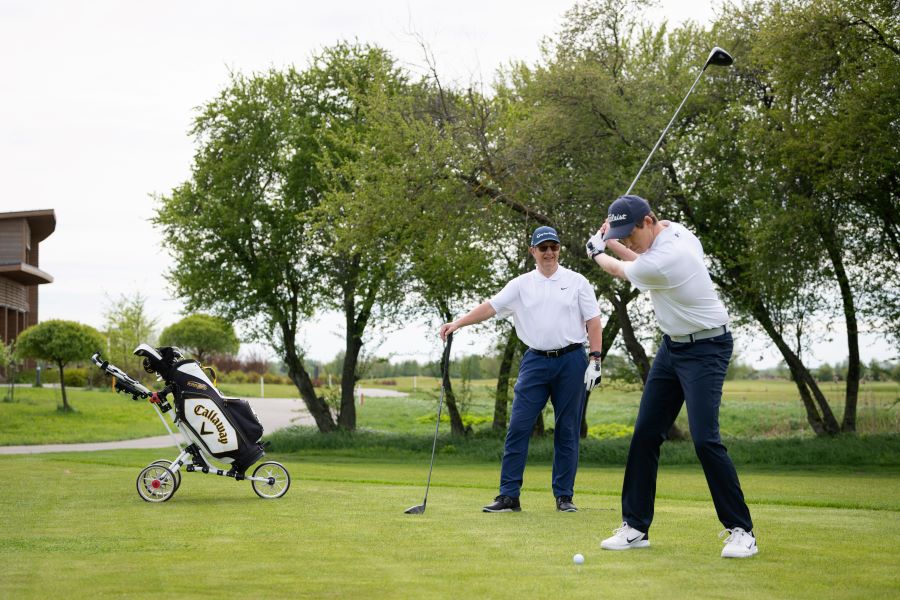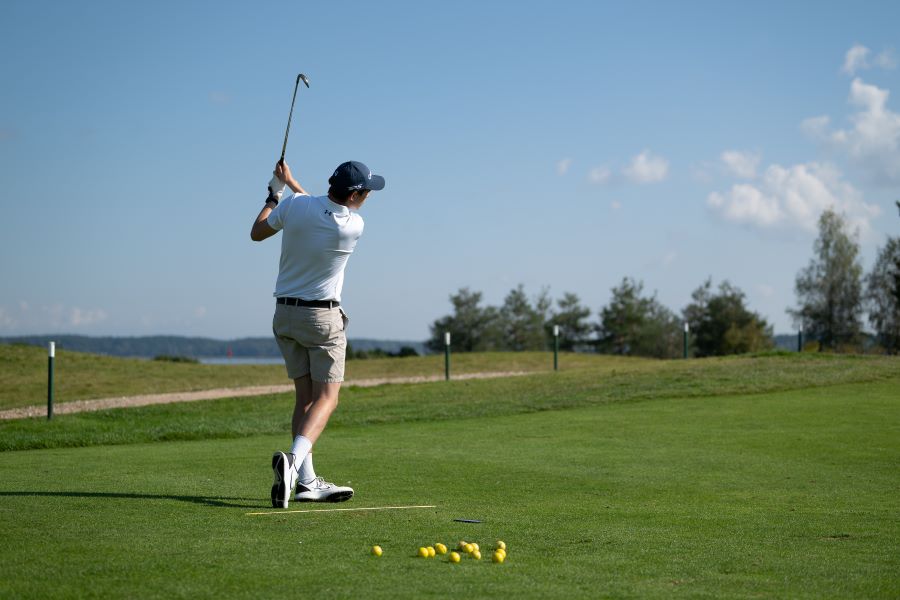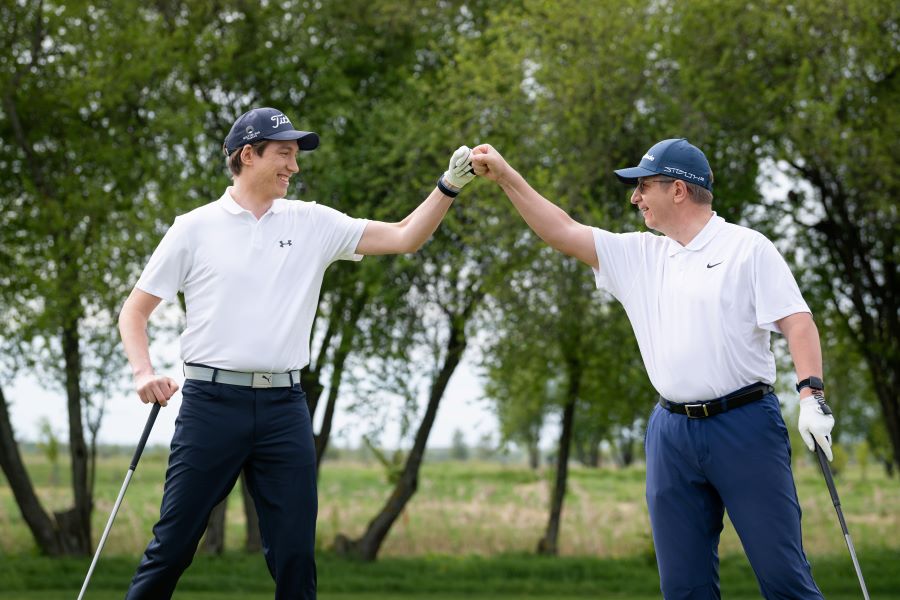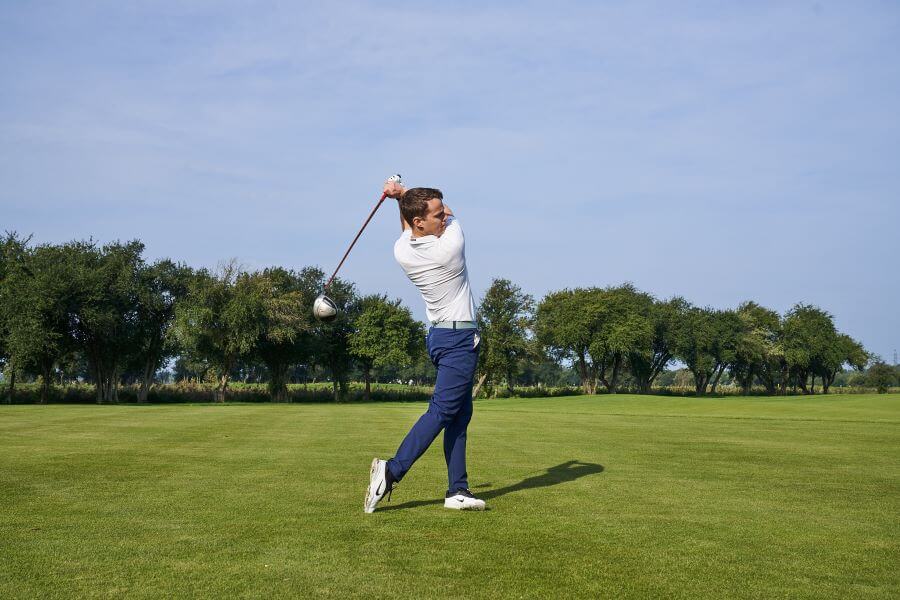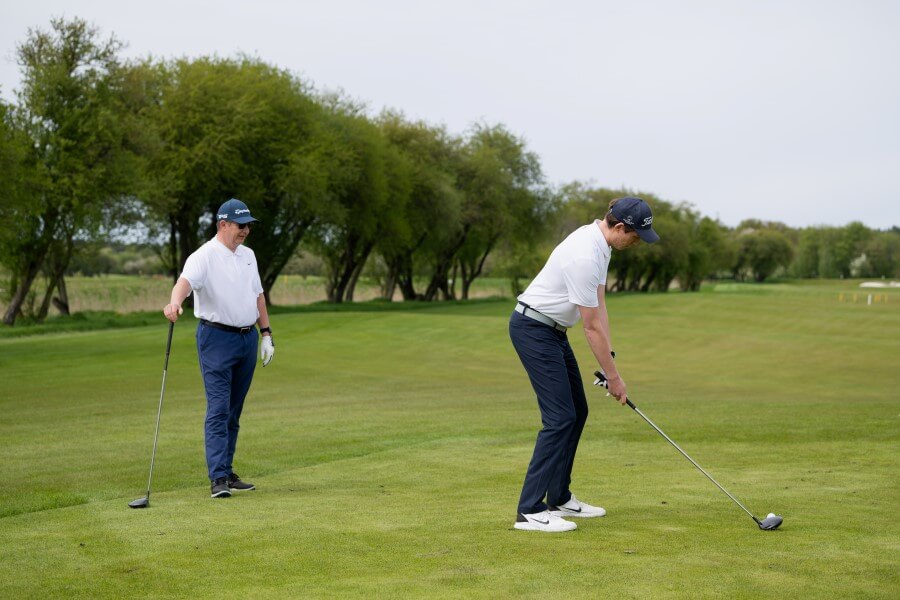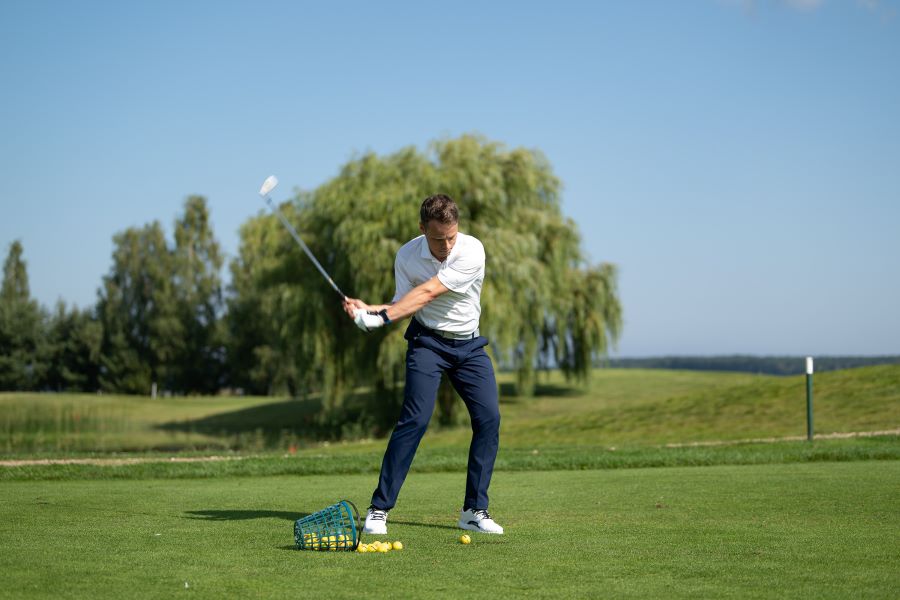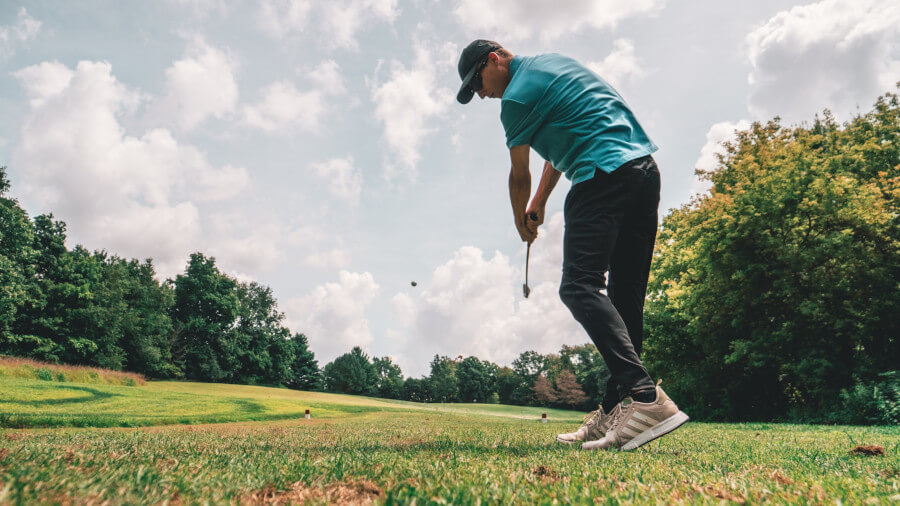9 Simple Left-Handed Golf Swing Tips to Lower Your Scores
Golf instruction videos and articles overwhelmingly cater to right-handed players, often leaving left-handed golfers to adapt tips that weren’t designed with them in mind.
This guide highlights 9 essential tips specifically for left-handed golfers, covering everything from equipment selection to proper alignment and wrist mechanics.
Left Handed Golf Swing Tips (Key Takeaways)
If you want to bookmark this left-handed golfer’s advice and come back to it later, here are the tips you can take with you right now:
- Remove trouble from the tee by aligning your ball with the widest landing zone.
- Neutral grip pressure for greater clubface control.
- Progressive ball position to promote clean contact.
- The pre-shot routine stimulates focus on the next shot.
- Forward shaft lean encourages less loft at impact to boost compression.
- Clubface square to the target line to set up for a straight shot.
- Aim to the left of the target for a draw.
- Line up to the right of the target for a fade.
- Maintain a consistent tempo for optimal release on the downswing.
- Flex wrists before impact to shallow the shaft and square the clubface.
Contents
- Advantages & Disadvantages of Being a Left-Handed Golfer
- 9 Left Handed Golf Swing Tips Every Golfer Should Know
- 1. Use the Tee Box to Your Advantage
- 2. Find the Right Grip Pressure for Better Clubface Control
- 3. Progressive Ball Position for Left-Handed Golfers
- 4. Forward Shaft Lean
- 5. Pre-Shot Routine
- 6. Set Up with the Clubface, and Wrists, Square to the Target
- 7. Make the Proper Adjustments to Shape Your Shots
- 8. Maintain Tempo
- 9. Flex Wrists Before Impact
- FAQs
- Final Thoughts
Advantages & Disadvantages of Being a Left-Handed Golfer
Left-handed golfers often face a mix of unique strengths and frustrating limitations.
Here’s a streamlined look at what helps and hurts when playing from the left side:
| Category | Advantage / Disadvantage | Details |
|---|---|---|
| Creativity | Advantage | Left-handers are often linked to stronger creative thinking. Mickelson and Bubba are known for inventive shot-making. |
| Club Availability | Disadvantage | Fewer stock options make it harder to find the right clubs off the rack. Fitting is usually the best route. |
| Golf Gloves | Disadvantage | Limited right-hand glove options, especially in cadet sizing, make finding a good fit tougher. |
9 Left Handed Golf Swing Tips Every Golfer Should Know
1. Use the Tee Box to Your Advantage
Start the hole by making a smart decision before you even swing. Look down the fairway and identify the side that gives you the most room for error.
Some tee boxes set up better for right handed players so you may need to think this one through a second longer.
- If the right side is more open, tee up on the left side of the box to give yourself a better angle.
- If there’s trouble, like water, out-of-bounds, or bunkers, on one side, tee up on the same side as the hazard to angle your shot away from it.
2. Find the Right Grip Pressure for Better Clubface Control
Left-handed golfers place the right hand on top and the left hand underneath the grip. One of the most important keys to consistent ball striking is using the right amount of grip pressure.
A grip that’s too tight limits your wrist mobility and shoulder turn. A grip that’s too loose makes it difficult to square the clubface and control the club during transition.
To find your ideal pressure, try this simple 3-step process:
- Step 1: Grip the club as tightly as possible and take a few practice swings. You’ll likely feel tension early in the swing and notice the clubface gets pulled too far inside.
- Step 2: Loosen your grip dramatically and swing again. With very light pressure, you may struggle to shallow the club and square the face at impact.
- Step 3: Adjust to a neutral pressure, firm enough to stay in control, but relaxed enough to allow fluid motion. Hit a few shots and fine-tune from there.
3. Progressive Ball Position for Left-Handed Golfers
For left-handed players, the right foot is the lead foot, the one closest to the target. Ball position should progress based on the club being used to promote clean contact and a square clubface.
Use this general guide:
- Driver: Ball aligned with the inside of your right heel (lead foot).
- Fairway woods / hybrids off the turf: Position the ball between the center and the inside of the right heel.
- Long irons: Slightly forward of center.
- Mid and short irons: Ball centered in the stance.
- Wedges: Ball just behind center for better control and cleaner turf interaction.
Longer clubs need more room to square up through impact, which is why they’re played farther forward. Shorter clubs square more quickly, so a more centered ball position ensures better compression and accuracy.
4. Forward Shaft Lean
Forward shaft lean promotes a delofted clubface at impact, increased compression, reduced spin, and consistent ball speed.
It doesn’t guarantee a quality strike, but it starts you on the correct path. Address the golf ball and tilt the shaft slightly towards the target, pushing your hands ahead of the ball.
If your shaft leans backward and your hands are behind the ball, you risk opening the clubface, creating more backspin, and lowering ball speed. The result is a weaker launching golf shot.
5. Pre-Shot Routine
While a pre-shot routine isn’t specific to left-handed golfers, it’s essential for every player who wants more focus and consistency.
The routine doesn’t have to be complicated; what matters most is that it helps you reset, commit, and prepare for the next shot.
Here’s a simple and effective structure to follow:
- Let go of the last shot, good or bad, and shift focus to the next one.
- Visualize your target and identify a safe landing zone based on the lie and club selection.
- Align the clubface with your intended target as you set your stance.
- Take 1–3 practice swings, checking rhythm and ball position relative to your contact point.
- Step behind the ball for a few seconds, take a final look, and commit to your shot.
- Step in, settle, and swing.
The entire routine should take no more than 20 seconds, but it can make a huge difference in how focused and confident you feel over every shot.
6. Set Up with the Clubface, and Wrists, Square to the Target
Controlling your clubface at setup is one of the most important parts of hitting straighter shots. However, it’s not just about aiming the face; your wrist angles and setup position also play a significant role in how the face is delivered at impact.
Start by aligning the clubface directly at your target, then set your feet parallel to that line. A square stance with a properly aimed face gives you the foundation for a neutral swing path.
To build consistency, focus on the position of your wrists at address:
- The lead wrist (left wrist for left-handed players) should have a small amount of extension, with around 20–25 degrees being ideal for most players.
- This slight “cupping” helps you start with a square face and deliver it consistently through impact.
- Too much extension at setup tends to open the face and promote high fades or slices.
- Less extension or a flatter wrist helps close the face, which can reduce slices and promote a draw.
Your handle height also affects this:
- A higher handle (more ulnar deviation) tends to reduce extension and help close the face, making it great for slicers.
- Lower handle increases extension and opens the face, useful for players who over-draw the ball.

The key is to replicate the same wrist position every time.
Start by finding a setup that produces your ideal ball flight, then use that as your baseline for future swings.
7. Make the Proper Adjustments to Shape Your Shots
To intentionally shape your shots, you’ll need to adjust your alignment and swing path.
Most golf instructional guides are written for right-handed golfers, so here is a simple look at how to do this properly for left-handed players.
- Fade (right to left) – Aim slightly right of your target and set up with a slightly open stance. Swing along an outside-in path with the clubface slightly left of that path. The ball will start right and curve back left.
- Draw (left to right) – Aim slightly left of your target and use a closed stance. Swing on an inside-out path with the clubface slightly right of the path. The ball will start left and draw back to the right.
Tip: Don’t aim directly at the flag when shaping shots. Always allow room for the curve so the ball can bend back toward your target line.
8. Maintain Tempo
A consistent tempo improves your transition, sequencing, and power. Most golfers benefit from a 3:1 ratio – your backswing should take about three times longer than your downswing.
To improve your rhythm:
- Stay relaxed at setup with a slight waggle or movement to avoid a rigid takeaway.
- Hold your finish after each swing. If you can’t, your tempo is likely off.
- Use drills like the Step Drill or 5-Ball Flow Drill (as seen in the video below) to build timing and feel.
With HackMotion Pro, you can track your tempo and see if you fall within the ideal range. Better tempo leads to better swings and better results.
9. Flex Wrists Before Impact
Wrist flexion, also known as bowing the lead wrist, is a key move that helps square the clubface and control your ball flight.
For left-handed golfers, that means flexing the right wrist during the downswing.
When timed correctly, this movement shallows the shaft, reduces slice spin, and leads to better compression and distance.
Instead of relying on feel alone, use HackMotion to measure your wrist angles from takeaway to impact and make sure you’re creating the right movement.
The Motorcycle Drill is a great way to work on wrist flexion just before impact.
Motorcycle Drill – Master Wrist Flexion in the Downswing
Focus on continuously adding flexion until the club reaches parallel, then smoothly complete your swing.
HackMotion Motorcycle Drill – Step by Step:
- Set Up: Address the ball in your normal stance.
- Simulate the Move: As you start your downswing, rotate your lead wrist like you’re revving a motorcycle—this adds flexion.
- Checkpoint at P6: Make sure your lead wrist is flexed when the shaft is parallel to the ground.
- Hold Through Impact: Maintain that flexed position into impact, then allow the wrist to release naturally.
- Practice Without a Ball: Rehearse slowly without a ball, then progress to hitting shots while monitoring wrist angles with HackMotion.
FAQs
Are right-handed golfers better at golfing than left-handed golfers?
No, right-handed golfers are not better at golfing than left-handed golfers. There are fewer left-handers. Golf Magazine suggests that only 5 to 7% of all golfers are left-handed, which explains why only four left-handers have won major tournaments.
Is golf more difficult for left-handed players?
No, golf is not more difficult for natural left-handed players. The challenges arise with sourcing equipment suited to your swing or gloves that fit your hand correctly.
Should a left-handed person play golf with their right hand?
No, a left-handed person shouldn’t play golf with their right hand because they will make the game more difficult for themselves.
How do you know if you are a left or right-handed golfer?
You know if you are a left or right-handed golfer based on the hand you use most for everyday tasks. If your left hand is the strongest, you are a left-handed golfer, which means you address the golf ball with your right foot closest to the target.
Why are there so few lefties in golf?
According to the BBC, there are so few lefties in golf because left-handers make up approximately 10% of the global population. With 800 million lefties globally, it makes sense that fewer golfers would be left-handed.
Final Thoughts
These left-handed golf tips focus on alignment, grip pressure, ball position, and wrist flexion before impact.
Keep the clubface square to your target, maintain light grip pressure, and adjust ball position—forward for longer clubs, back for shorter ones.
A smooth tempo helps create a better transition and more acceleration through impact. And don’t forget to add wrist flexion before contact to help shallow the shaft and close the clubface.
With the HackMotion wrist sensor, you can track wrist angles from address to impact and measure your tempo for more consistent swings.





